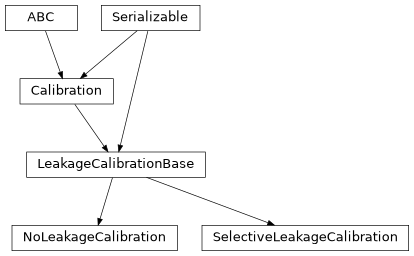Leakage Calibration¶

- class LeakageCalibrationBase(device=None)[source]¶
Bases:
Calibration,SerializableAbstract base class for all leakage calibration classes.
- abstract predict_leakage(transmitted_signal)[source]¶
Predict the leakage of a transmitted signal.
Returns: The predicted leakage.
- abstract remove_leakage(transmitted_signal, received_signal)[source]¶
Remove leakage from a received signal.
- Parameters:
transmitted_signal (
Signal) – The transmitted signal.recveived_signal – The received signal from which to remove the leakage.
- Return type:
Returns: The signal with removed leakage.
- hdf_group_name = 'leakage_calibration'¶
Group name of the calibration in the HDF save file.
- class SelectiveLeakageCalibration(leakage_response, sampling_rate, delay=0.0, physical_device=None)[source]¶
Bases:
LeakageCalibrationBaseCalibration of a frequency-selective leakage model.
- Parameters:
- classmethod Deserialize(process)[source]¶
Deserialize an object’s state.
Objects cannot be deserialized directly, instead a
Factorymust be instructed to carry out the deserialization process.- Parameters:
process (
DeserializationProcess) – The current stage of the deserialization process. This object is generated by theFactoryand provides an interface to deserialization methods supporting multiple backends.- Return type:
- Returns:
The deserialized object.
- static LeastSquaresEstimate(device, num_probes=7, num_wavelet_samples=4673, configure_device=True, filter_calibration=True)[source]¶
Estimate the transmit-receive leakage for a physical device using Leat-Squares estimation.
- Parameters:
device (
PhysicalDevice) – Physical device to estimate the covariance matrix for.num_probes (
int) – Number of probings transmitted to estimate the covariance matrix. \(7\) by default.num_wavelet_samples (
int) – Number of samples transmitted per probing to estimate the covariance matrix. \(4673\) by default.configure_device (
bool) – Configure the specified device by the estimated leakage calibration. Enabled by default.filter_calibration (
bool) – Filter the estimated calibration to consider only prominent peaks. Enabled by default.
- Return type:
Returns: The initialized
SelectiveLeakageCalibrationinstance.- Raises:
ValueError – If the number of probes is not strictly positive.
ValueError – If the number of samples is not strictly positive.
- static MMSEEstimate(device, num_probes=7, num_wavelet_samples=127, noise_power=None, configure_device=True)[source]¶
Estimate the transmit receive leakage for a physical device using Minimum Mean Square Error (MMSE) estimation.
- Parameters:
device (
PhysicalDevice) – Physical device to estimate the covariance matrix for.num_probes (
int) – Number of probings transmitted to estimate the covariance matrix. \(7\) by default.num_wavelet_samples (
int) – Number of samples transmitted per probing to estimate the covariance matrix. \(127\) by default.noise_power (
ndarray|None) – Noise power at the receiving antennas. If not specified, the device’s noise power configuration will be assumed or estimated on-the-fly.configure_device (
bool) – Configure the specified device by the estimated leakage calibration. Enabled by default.
- Return type:
Returns: The initialized
SelectiveLeakageCalibrationinstance.- Raises:
ValueError – If the number of probes is not strictly positive.
ValueError – If the number of samples is not strictly positive.
ValueError – If the noise power is negative.
- estimate_delay()[source]¶
Estimate the delay of the leakage model.
- Return type:
- Returns:
The delay of the leakage model in seconds.
- predict_leakage(transmitted_signal)[source]¶
Predict the leakage of a transmitted signal.
Returns: The predicted leakage.
- remove_leakage(transmitted_signal, received_signal)[source]¶
Remove leakage from a received signal.
- Parameters:
transmitted_signal (
Signal) – The transmitted signal.recveived_signal – The received signal from which to remove the leakage.
- Return type:
Returns: The signal with removed leakage.
- serialize(process)[source]¶
Serialize this object’s state.
Objects cannot be serialized directly, instead a
Factorymust be instructed to carry out the serialization process.- Parameters:
process (
SerializationProcess) – The current stage of the serialization process. This object is generated by theFactoryand provides an interface to serialization methods supporting multiple backends.- Return type:
- class NoLeakageCalibration(device=None)[source]¶
Bases:
LeakageCalibrationBaseNo leakage calibration.
- classmethod Deserialize(process)[source]¶
Deserialize an object’s state.
Objects cannot be deserialized directly, instead a
Factorymust be instructed to carry out the deserialization process.- Parameters:
process (
DeserializationProcess) – The current stage of the deserialization process. This object is generated by theFactoryand provides an interface to deserialization methods supporting multiple backends.- Return type:
- Returns:
The deserialized object.
- predict_leakage(transmitted_signal)[source]¶
Predict the leakage of a transmitted signal.
Returns: The predicted leakage.
- remove_leakage(transmitted_signal, received_signal)[source]¶
Remove leakage from a received signal.
- Parameters:
transmitted_signal (
Signal) – The transmitted signal.recveived_signal – The received signal from which to remove the leakage.
- Return type:
Returns: The signal with removed leakage.
- serialize(process)[source]¶
Serialize this object’s state.
Objects cannot be serialized directly, instead a
Factorymust be instructed to carry out the serialization process.- Parameters:
process (
SerializationProcess) – The current stage of the serialization process. This object is generated by theFactoryand provides an interface to serialization methods supporting multiple backends.- Return type: